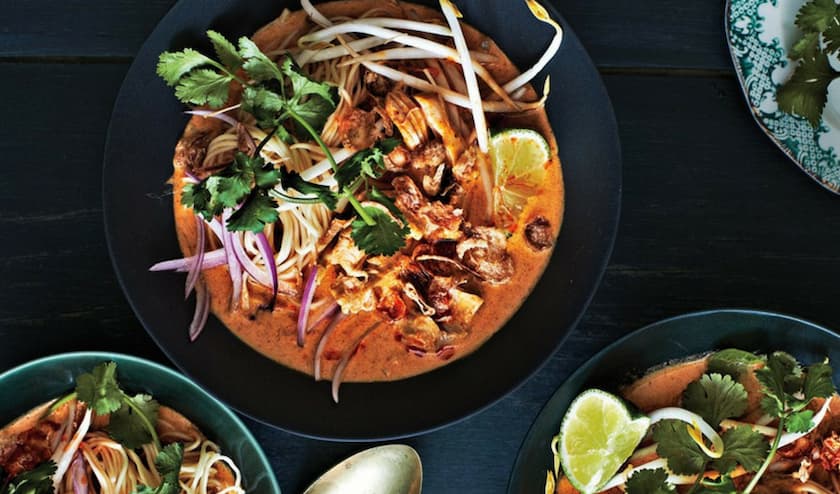How to Enjoy Chiang Mai’s Local Cuisine: A Culinary Guide
Discover the Flavors of Northern Thailand
Chiang Mai, a city rich in culture and history, is also a haven for food lovers. Its cuisine is distinct from the rest of Thailand, featuring unique flavors, bold spices, and local ingredients. Whether you’re enjoying street food or dining in a local restaurant, Chiang Mai’s local dishes offer an authentic taste of Northern Thailand’s culinary traditions.
Must-Try Local Dishes in Chiang Mai
Khao Soi – The Signature Dish
One of the most famous dishes of Chiang Mai is Khao Soi, a delicious coconut curry noodle soup. It features soft egg noodles in a rich, creamy curry broth, topped with crispy noodles and served with pickled mustard greens, onions, and lime. Khao Soi is a must-try for anyone visiting the region and can be found at many street stalls and restaurants throughout the city.
Sai Ua – Northern Thai Sausage
Sai Ua, or Northern Thai sausage, is a flavorful grilled pork sausage seasoned with herbs and spices such as lemongrass, kaffir lime leaves, and chili. It’s often served with sticky rice and is a favorite snack for both locals and visitors. You can find this at local markets and street vendors across Chiang Mai.
Nam Prik Ong – Spicy Tomato Dip
Nam Prik Ong is a Northern Thai chili dip made with ground pork, tomatoes, and a variety of spices. It’s typically served with fresh or steamed vegetables and sticky rice, making it a perfect appetizer or side dish. Another variation, Nam Prik Noom, is a green chili dip that’s just as popular in local eateries.
Gaeng Hang Lay – Northern Pork Curry
Gaeng Hang Lay is a rich, flavorful pork curry that’s different from traditional Thai curries. This dish is mild and features a blend of ginger, garlic, and tamarind, offering a slightly tangy and sweet flavor. It’s a great choice for those who enjoy a hearty, comforting meal.
Khan Toke – Traditional Lanna Feast
For an authentic Chiang Mai dining experience, try a Khan Toke dinner, a traditional Lanna meal served on a low round table. The meal typically includes sticky rice, spicy dips, curries, and fried pork, all while enjoying traditional Thai music and dance performances. This is not just a meal but a cultural experience.
Best Places to Experience Chiang Mai’s Cuisine
Street Food Markets
Chiang Mai is famous for its vibrant street food scene. Chiang Mai Gate Market and Sunday Walking Street are popular spots to try a wide variety of local dishes. From grilled skewers to fresh fruit smoothies, these markets offer a great opportunity to sample Northern Thai flavors at affordable prices.
Local Restaurants
Chiang Mai has many local eateries offering authentic Northern Thai cuisine. Restaurants like Khao Soi Khun Yai and Tong Tem Toh are well-known for serving traditional dishes in a welcoming atmosphere. Whether you’re craving Khao Soi or a spicy chili dip, these local favorites won’t disappoint.
Cooking Classes
For those who want to take a piece of Chiang Mai’s culinary traditions home, consider joining a cooking class. Many cooking schools in the city offer lessons on how to make iconic Northern Thai dishes. Asia Scenic and Thai Farm Cooking School are popular options where you can learn hands-on how to create your favorite dishes.
Tips for Enjoying Chiang Mai’s Local Cuisine
Be Adventurous, But Mind the Spice
Northern Thai cuisine is known for its bold and spicy flavors, so don’t be afraid to try something new. However, if you’re sensitive to spice, ask for “mai phet” (not spicy) or only a little chili to enjoy the flavors without overwhelming heat.
Eat Where the Locals Eat
One of the best ways to experience authentic Chiang Mai cuisine is to follow the locals. Visit busy street food stalls and restaurants, where the high turnover means fresh and delicious food.
Stay Safe with Food and Water
While Chiang Mai’s street food is generally safe, it’s best to stick to freshly cooked dishes. Avoid uncooked foods like salads and be cautious with tap water—stick to bottled water for drinking.
Conclusion – Savoring the Best of Chiang Mai’s Cuisine
Chiang Mai’s local cuisine is a reflection of its rich culture and history, offering a wide range of flavors that will delight any food lover. Whether you’re enjoying a bowl of Khao Soi at a street stall, savoring Northern sausage, or participating in a traditional Khan Toke dinner, you’re sure to leave Chiang Mai with unforgettable culinary memories. Be sure to explore the markets, try new dishes, and embrace the bold flavors that make Chiang Mai a food lover’s paradise.


